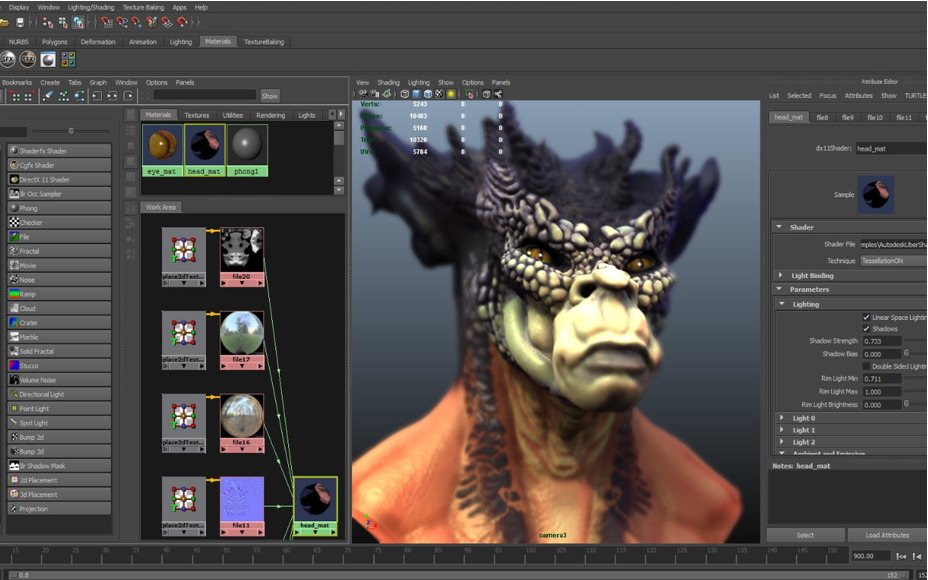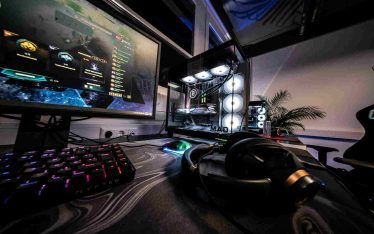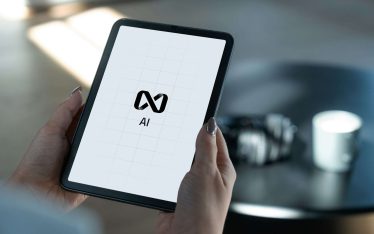
Image 1. An Element of GUI Autodesk Maya LT written in Qt.
Qt is the most suitable framework for the commercial application of a cross-platform GUI library available for C++, Python, Go, and some other languages. Of course, developers are free to choose from among many other frameworks for designing user interfaces: wxWidgets, JUCE, CEGUI, Tk, or even GTK. But each of these frameworks has specific bottlenecks. While Qt has its own challenges, we believe they are fewer than in any other GUI framework, especially with the latest advancements in Qt 6.
Qt is time-proven and perhaps the most well-known, well-documented, and well-supported framework. Qt is positioned as a tool for creating consistent multi-platform UIs, or rather as the company states, “fluid, high-performance, and intuitive UIs.” Naturally, Developex Company uses all these benefits to create many of our projects for multiple platforms.
QML: The Modern Language for Rapid UI Development
What makes Qt a powerful tool for modern cross-platform development is QML, the Qt Meta Language. It is a declarative language with a simple, JSON-based syntax that makes it possible to build robust, modern UIs with relative ease. The inline JavaScript code handles imperative aspects, and QML provides an API to extend the language with custom types and integrate QML code with JavaScript and C++. QML is mainly used for creating user-centric applications where touch input, fluid animations (60 FPS), and a flawless user experience are crucial, making it ideal for mobile, embedded, and modern desktop applications.
Qt Controls: Bridging the Gap to Native UI
One of the historical challenges with Qt was a perceived inability to create UIs that looked identical to native platform controls, particularly on macOS and iOS. However, Qt has significantly advanced its approach. The Qt Quick Controls 2.0 library, introduced in Qt 5.8 and significantly enhanced in Qt 6, offers a new approach. It focuses on creating cross-platform controls that are not just wrapped snapshots but are deeply integrated and highly customizable. This approach accommodates modern design principles like Google Material Design and Windows Phone Guidelines, ensuring a familiar yet flexible user experience. With Qt 6, the new rendering hardware interface (RHI) further improves performance, making animations and transitions smoother than ever before.
Also, there are separate extensions such as the QML Theme and Component Library for Android, Material Design components using Qt/QML and QML Theme and Component Library for iOS.
Core Qt Modules and Capabilities
There are many other features that make Qt a top-tier framework for making a GUI.
Windowing System
The Qt GUI module provides classes for windowing system integration, event handling, OpenGL, and OpenGL ES integration. These classes can be used directly or through higher-level APIs like Qt Quick. The 2D Graphics module contains classes for advanced typography and imaging, while QWindow supports graphics rendering using Vulkan, Metal, Direct3D, and OpenGL, depending on platform support. This provides the foundation for creating user interfaces with advanced features like maps, charts, and data visualizations.
Qt Quick and Other Tools
Qt provides its own designer, making it simple to create good GUIs with the help of spacers, buttons, and HTML editors. The Qt Quick library reduces the effort required for designing UIs, and with modules like Qt Controls and Qt Layouts, developers can significantly reduce development time. The integration of Qt Design Studio facilitates seamless collaboration between designers and developers, speeding up the entire UI creation workflow.
Animations
Qt Quick and QML provide powerful capabilities to animate properties and facilitate the creation of fluid UIs. These UIs are dynamic and engaging, as components animate rather than abruptly appearing or disappearing. This is a key factor in improving user satisfaction and retention.
UX
With Qt 6, the framework handles touch, mouse, and keyboard input seamlessly. The Qt Sensors and Qt Positioning modules enable reactions to a touch that are common for most portable devices, providing access to hardware like accelerometers, compasses, and gyroscopes. This robust support for gestures and sensors is vital for modern mobile and embedded devices.
Web Engine
Qt WebEngine is a web content rendering engine based on the Chromium open-source project. It supports all standard web technologies and features and can be integrated with Qt Quick and other widgets. The module is complemented by Qt WebChannel, which bridges the gap between QML/C++ and HTML/JavaScript, allowing for the easy sharing of QObjects and data.
Multimedia
The multimedia capabilities of Qt are represented by a rich set of QML types and C++ classes that handle multimedia content. Qt Multimedia Classes are developed for audio, video, radio, and camera functionality, and are supported on all major platforms, making it easy to create media-rich applications.
Qt in Action: Industry-Specific Solutions
Qt’s cross-platform capabilities and high-performance are particularly beneficial for several key industries that rely on sophisticated user interfaces.
- Automotive & Marine: Qt is the premier choice for developing digital cockpits, in-vehicle infotainment (IVI) systems, and navigation displays. Its high-performance graphics and robust stability are essential for creating real-time HMIs (Human-Machine Interfaces) that are critical for safety and a great user experience.
- Medical Devices: In this highly regulated field, Qt is used to build compliant, reliable, and intuitive HMIs for diagnostic and patient monitoring equipment. The framework’s long-term support and code stability are vital for products with long lifecycles.
- Industrial Automation & IoT: For factory automation, control panels, and smart devices, Qt allows for the creation of responsive and scalable UIs. Its low-footprint design is perfect for embedded systems, while its networking modules enable connectivity for Industrial IoT applications.
- Consumer Electronics: From smart TVs to wearables, Qt is leveraged to build the user interfaces that define the user experience. Its ability to run on low-power, embedded hardware makes it an ideal choice for this sector.
Real-World Applications of Qt
The true power of Qt is best demonstrated through the diverse range of applications it powers. Beyond popular desktop apps like Telegram Messenger and Google Earth, Qt is the backbone of mission-critical software and stunning user interfaces in major industries.
Qt For Desktop and Enterprise Applications
While the Telegram desktop client and Google Earth are great examples of Qt’s ability to create consistent and performant cross-platform UIs, many other professional-grade applications also rely on the framework. These include:
- Adobe Photoshop Album & Elements: These professional graphics software suites use Qt for their user interfaces, showcasing its capability to handle complex layouts and resource-intensive operations.
- Autodesk Maya: As highlighted by the article, this 3D animation and modeling software uses Qt for its GUI, which is a testament to the framework’s power in handling intricate and highly functional user interfaces for creative professionals.
- VLC Media Player: The popular open-source media player uses Qt to deliver a robust and user-friendly experience on all major operating systems.
- OBS Studio: This widely used open-source software for video recording and live streaming relies on Qt for its cross-platform UI, demonstrating its utility in the media and entertainment sectors.
- KDE Plasma: This open-source desktop environment for Linux systems is built entirely on Qt, representing one of the largest and most comprehensive Qt projects in existence.
Qt For Automotive and Transportation
Qt has become the standard for modern In-Vehicle Infotainment (IVI) systems and digital instrument clusters. Automakers use Qt to create seamless, responsive, and visually stunning digital cockpits. The framework’s ability to deliver high-performance graphics on constrained hardware makes it ideal for these demanding environments. Notable examples include:
- Tesla’s Model S and other vehicle UIs: The iconic touchscreen interface in Tesla vehicles, which controls everything from navigation to climate, is a prime example of Qt’s power in the automotive space.
- Audi MMI: Audi’s multi-media interface system has incorporated Qt for a number of years, providing a premium and consistent user experience across its luxury vehicles.
- Volkswagen: Volkswagen has used Qt to develop digital dashboards and other displays for their vehicles, leveraging the framework’s efficiency to reduce memory consumption and accelerate development.
Qt For Medical Devices
In the medical field, where reliability and safety are paramount, Qt is a trusted choice for building the user interfaces of medical devices. The framework’s long-term support and stability are critical for products that have a long service life and must meet stringent regulatory standards. Examples include:
- Surgical Robots and Imaging Systems: Qt is used to build the sophisticated UIs for robotic surgical assistants and advanced imaging devices, which require precision and real-time data visualization.
- Patient Monitoring Systems: Devices that monitor vital signs and other patient data often use Qt for their HMIs, ensuring clarity and ease of use for medical professionals.
- Anesthesia Ventilators: The touchscreens and control systems for ventilators are often built with Qt, where a smooth, reliable, and responsive interface can be a matter of life and death.
Qt For Industrial Automation
Qt is a key technology in the push towards Industry 4.0. It’s used to create robust and reliable Human-Machine Interfaces (HMIs) for factory automation, control panels, and SCADA systems. Qt’s ability to handle large data sets, real-time graphics, and network connectivity makes it perfect for these environments. Examples include:
- BOMAG myCOCKPIT: This HMI for construction vehicles is powered by Qt, providing operators with a modern, intuitive control system.
- Factory Monitoring Systems: From conveyor belts to robotics, Qt UIs are used to visualize and control complex industrial processes.
- Digital Twins: Qt’s 3D capabilities are used to create real-time digital replicas of physical systems, allowing for remote monitoring and predictive maintenance.
These examples illustrate that Qt is not just for generic software; it’s a powerful and versatile platform trusted by leading companies in some of the world’s most demanding industries. This broad application base is a strong indicator of its reliability, performance, and commercial viability.
Why Partner with Developex for Your Qt Project?
While Qt provides a powerful toolkit, unlocking its full potential and tailoring it to your specific business needs requires deep, specialized expertise. Developex has a long-standing history of successfully delivering complex, high-performance Qt projects for clients across the globe.
We specialize in:
- Custom Qt Application Development: We build bespoke cross-platform applications from the ground up, designed to meet your unique functional and commercial requirements.
- UI/UX Modernization: We can update your existing applications, migrating them to the latest Qt versions (Qt 6) and modernizing their UI/UX to enhance user engagement and extend their market life.
- Team Augmentation: If you already have an in-house team, we can provide senior Qt developers to fill skill gaps, accelerate development, and ensure your project stays on track.
- Industry-Specific Solutions: Our experience in automotive, medical, and industrial automation gives us a unique advantage. We understand the specific challenges and regulatory needs of these industries, ensuring your product is not only functional but also compliant and competitive.
Ready to transform your product with a state-of-the-art UI?
Contact us today to discuss your project. We’ll show you how our expertise can help you reduce costs, accelerate your time-to-market, and create a truly exceptional product.






